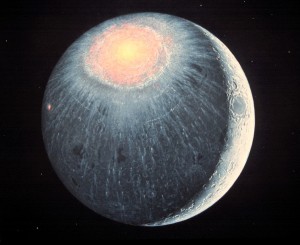Cataclysmic Events on the Moon
NASA recently announced that it has down-selected three New Frontiers mission concepts for additional study.

NASA recently announced that it has down-selected three New Frontiers mission concepts for additional study. One of these missions, Moonrise, proposes to return rock and soil samples from the floor of the largest impact crater on the Moon, the South Pole-Aitken (SPA) basin, centered on the southern far side. Not only is this the largest basin on the Moon, it is also the oldest, as evidenced by a high density of impact craters superposed on top of its deposits. But knowing that it is the oldest basin does not tell us exactly when it formed. Samples collected from its floor could potentially determine exactly when, during the early history of the Moon, it was created.
Why is the absolute age of this feature important? When lunar samples are returned to Earth as they were by the Apollo missions forty years ago, they are subjected to virtually every conceivable chemical and mineral analysis we can imagine. From those studies we have reconstructed a rough outline of lunar history and the processes that have shaped it. From this work (which produced reams of detailed data on the elemental composition and make-up of the Moon) came the startling discovery that, not only is the heavily cratered crust of the Moon very old (older than 3.8 billion years), but that the largest impact features of that crust seemed to have formed at the very end of that early period.
The Moon’s molten crust solidified 4.3 billion years ago. Virtually all highland rocks assembled in large impact events date from around 3.8 billion years ago. Because it was believed that many of these impact events had been sampled by the Apollo missions, it was inferred that the Moon underwent a massive bombardment of large body projectiles, all closely sequenced at that time. This time period is referred to as the lunar “cataclysm” or the “late heavy bombardment.” As both Earth and Moon orbit the Sun at the same distance, an impact cataclysm affecting the Moon also would have affected the early Earth.
A late, cataclysmic bombardment of the Earth-Moon system was not predicted by the then-existing models of lunar formation and growth. In an unexpected turn, this time period (3.8 billion years ago) was significant in another respect, as it is the oldest epoch from which we have preserved fossil (bacterial) life in Earth’s rock record. Does this mean there is a connection between the end of the early, heavy impact bombardment and the emergence of life on Earth? It is very tempting to make this connection but when missions to the Moon ended, our ability to continue down this path of scientific inquiry also ended. If we are ever able to draw such a paradigm-changing conclusion, we must first determine if the lunar cataclysm really happened.
Two things about the Apollo samples must be considered. First, all were collected from six landing sites in the vicinity of the central, equatorial near side. The large Imbrium basin is one of the youngest on the Moon—it subdivides lunar history and determining its absolute age was a top priority; at least two of the Apollo mission sites were chosen to address the composition and age of the Imbrium basin and two (and possibly the remaining four) additional sites are well within the possible influence of this large feature. Thus, although we cannot be certain, many of the Apollo highland samples may contain the imprint of this single, watershed event, obscuring the record of earlier impacts.
Second, the nature of the Moon itself works against our understanding of the geological context of the returned samples. The Moon has had a complex history, whereby rocks were thrown hundreds of kilometers across its surface, mixed up with other deposits thrown out from other craters and basins, along with periodic lava flooding. The continuous impact bombardment of the Moon for billions of years has “sandblasted” the crust into a crushed mixture of rock and fine powder (called regolith) that covers the surface. True rock outcrop is hard to find and virtually none of the Apollo missions sampled it.
Although a lunar sample can be subjected to excruciatingly detailed measurements and age determinations, such data are valueless unless you are able to relate the sample to some larger, regional geological unit. In the case of the impact cataclysm, how many and which basins did the Apollo missions sample? Unless we can answer that question with some certainty, we cannot be sure that a “cataclysm” occurred – we may be looking at only the last (or last few) largest basin-forming impacts.
To resolve the issue of the cataclysm, we must collect samples from older, distinctly different impact basins, preferably far removed from the zones where Apollo explored. Hence, we desire to collect samples from an area exactly opposite to the near side Apollo sites—the far side’s South Pole-Aitken, the largest and oldest basin on the Moon. If we sample impact melt from this event, we could determine the age of SPA with a degree of confidence and understand whether all basins formed at nearly the same time (which would be the case if SPA is the same 3.85 billion year age as the near side Imbrium basin, sampled by Apollo) or if the formation of the basins was spread out over 400 million years, as would be the inference if SPA is 4.3 billion years old.
Obtaining this key sample would be monumentally important for lunar science. Does this sound too good to be true? Perhaps, but it is exciting to anticipate the possibilities of such a discovery.
In my next post, I will discuss some of the difficulties in deciphering the cratering history of the Moon from its rocks.
/https://tf-cmsv2-smithsonianmag-media.s3.amazonaws.com/accounts/headshot/blog_headshot_spudis-300x300.jpg)
/https://tf-cmsv2-smithsonianmag-media.s3.amazonaws.com/accounts/headshot/blog_headshot_spudis-300x300.jpg)